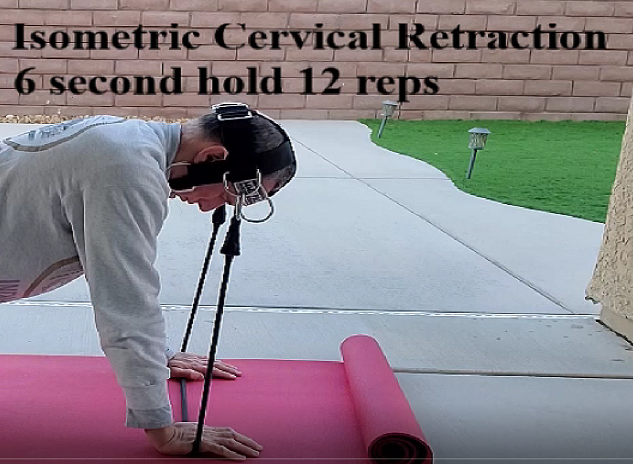Increase neck strength with banded cervical spine strengthening exercises. Banded exercises provide resistance through the entire range of motion. Develop proportional neck strength by strengthening the sternocleidomastoids, scalenes, levator scapula, trapezius, deep cervical flexors and cervical paraspinals. The cervical spine is medical name for the neck. Strong cervical spine muscles may help decrease the risk of concussions and post-concussion syndrome. Perform all exercises through a symptom free range of motion. Control the eccentric phase of the motion and move in a slow and controlled manner. Never execute an exercise that elicits or intensifies symptoms.
Banded Resisted Isometric Cervical Retraction
Sit/stand or kneel in good posture.
Thoracic spine straight. Chin parallel to floor. Scapulae retracted.
With both hands securely hold band in front of you at height of attachment to head harness
Band secured to both sides of neck harness.
Slowly move head & neck straight backwards (Retraction).
Hold isometric contraction for two to six seconds.
Slowly return to starting position.
Build to fifteen reps
Kneel in good posture. Keep thoracic spine straight through entire exercise.
With both hands behind the back, tightly hold the band.
Band secured to both sides of neck harness.
Extend neck as far as possible through a pain free range of motion. This is the starting position.
Flex neck as far as possible through a pain free range of motion.
Slowly return to starting position by controlling the eccentric motion.
Move in a slow and controlled manner through a pain free range of motion.
Build to fifteen reps.
Knees and palms on floor. Palms should be close to knees.
Band securely under both palms.
Band secured to both sides of neck harness.
Keep thoracic spine straight through entire exercise.
Flex neck as far as possible through a pain free range of motion. This is the starting position.
Extend neck as far as possible through a pain free range of motion.
Slowly return to starting position by controlling the eccentric motion.
Move in a slow and controlled manner through a pain free range of motion.
Build to fifteen reps.
Banded Cervical Lateral Flexion
Stand, sit or kneel in good posture.
Keep thoracic spine straight through entire exercise.
Band secured to front and back of neck harness.
To perform left lateral flexion. With right arm, securely hold the band at arms-length at height of attachment to head harness. Right hand should be out to the right side and in line with the shoulder.
Laterally flex neck to right as far as possible through a pain free range of motion. This is the starting position.
Laterally flex neck to left as far as possible through a pain free range of motion.
Slowly return to starting position by controlling the eccentric motion.
Move in a slow and controlled manner through a pain free range of motion.
Build to fifteen reps.
Repeat to opposite direction.
Stand, sit or kneel in good posture. Keep thoracic spine straight through entire exercise.
Band secured to front and back of neck harness.
To perform left rotation. With right arm, securely hold the band at arms-length at height of attachment to head harness. Right hand should be out to the right side and slightly posterior to the shoulder.
Rotate neck to right as far as possible through a pain free range of motion. This is the starting position. Make sure there is tension in the band at the starting position.
Rotate neck to left as far as possible through a pain free range of motion.
Slowly return to starting position by controlling the eccentric motion.
Move in a slow and controlled manner through a pain free range of motion.
Build to fifteen reps.
Repeat to opposite direction.
Build proportional neck strength to correct postural impairments such as upper cross syndrome. Increase cervical spine strength to decrease the risk of cervical sprain/strains, cervical disc herniations, burners/stingers, cervical radiculopathies, concussion and post-concussion syndrome. Strengthen your neck to enhance your athletic performance.
References
Effect of Assistive Device for Neck Retraction (ANR) on Neck Muscles during Neck Retraction Exercise https://www.ncbi.nlm.nih.gov/pmc/articles/PMC3804973/
Cervical Spondylosis https://www.ncbi.nlm.nih.gov/books/NBK551557/
The Best Exercises for A Thicker, Stronger Neck https://fitnessvolt.com/best-neck-exercises/
Effect of Neck Muscle Strength and Anticipatory Cervical Muscle Activation on the Kinematic Response of the Head to Impulsive Loads https://www.ncbi.nlm.nih.gov/pmc/articles/PMC4344320/
Potential Role of the Cervical Spine in Sports-Related Concussion: Clinical Perspectives and Considerations for Risk Reduction https://www.ncbi.nlm.nih.gov/pmc/articles/PMC7102493/
Disclaimer: Viewing this video does not take the place of seeing a medical professional, receiving proper training in the medical profession or working with a fitness professional. Please visit a medical professional for evaluation, diagnosis and treatment. Please work with a fitness professional to learn proper exercise technique and to develop a proper training program. Never perform an exercise that elicits or intensifies symptoms. If an exercise elicits or intensifies symptoms, stop immediately and use a viable substitute. Please receive proper medical training before attempting these medical procedures.
Dr Donald A Ozello DC of Championship Chiropractic in Las Vegas, NV
Web Site: http://www.championshipchiropractic.com/
Blog: https://www.championshipchiropractic.com/wordpress/
Twitter: https://twitter.com/drdozellodc
Facebook: https://www.facebook.com/Championship-Chiropractic-280141628688300/
LinkedIn: https://www.linkedin.com/in/dr-donald-a-ozello-dc-716b3233
YouTube: https://www.youtube.com/user/drdozellodc/videos
“Running: Maximize Performance & Minimize Injuries” https://www.amazon.com/Running-Performance-Chiropractors-Minimizing-Potential/dp/1493618741

